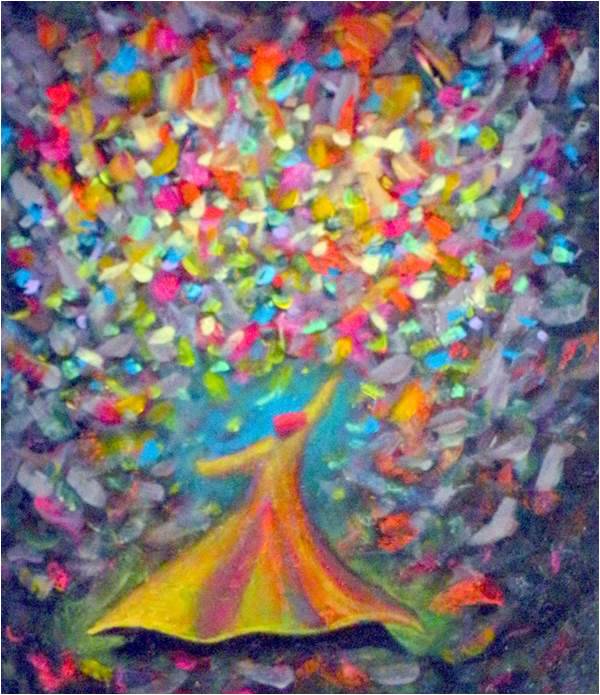
“O! for a Muse of fire that would ascend
The brightest heaven of invention;
A kingdom for a state, princes to act
And monarchs to behold the swelling scene ...”
These words from Shakespeare’s “Henry V” certainly bring to mind the art of Karachi artist Khusro Subzwari, who being invited in June and July 2011 to participate in international group exhibitions in Turkey saw the renowned Sufi whirling dervishes for the first time and became totally absorbed in the spirituality of their dance. As soon as he returned home, still struck by this muse, he got to painting this “brightest heaven of invention” he had seen and experienced in Turkey.
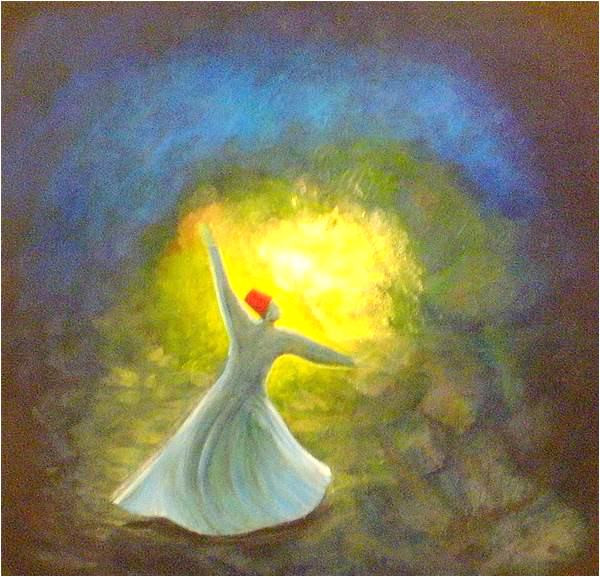
An engineer by profession – having gained his Master’s degree in Civil Engineering from the University of Oklahoma in 1985 – Sabzwari first received an award in 1981 for an oil painting entered in a competition judged by the revered Gulgee. But it was at his flood relief exhibition in 2010 on the theme of “Global Warming and our Earth’s Beauty” that he first created an impression on larger audiences, having since then given a respectable number of solo shows and participated in many group exhibitions for charity, alongside displaying his work in Lugano (Switzerland), Abu Dhabi and London.
[quote]Sufi means literally the wearer of wool[/quote]
When asked if he believes in inspiration Khusro says, “Yes. Sometimes I feel refreshed and creative even after seeing other people’s exhibitions and for a few hours afterwards I feel like painting. Apart from that, two or three times a week I wake up during the night and paint until Fajr regardless of current exhibition or other plans. But apart from the sudden urges I also have a regular morning work schedule where I complete what I have begun in the night.” Inspired by Rumi, he says, “We are not the artists, we are paintbrushes in the hand of God.”
He was never interested in Rumi till he saw those dancers in Turkey. Since then his work has been more focused on creation, nature and the invisible spiritual world, owing also to his desire to spread awareness of things beyond the earth. “There is no harm in following the crowd and making money,” he says,” but there is this other dimension which must be expressed. Material things become a prison.”
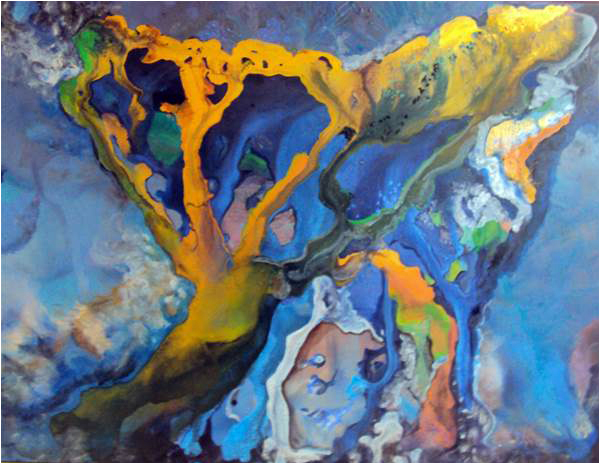
I went to see Khusro Subzwari’s “Enlightenment of the Soul” exhibition at Karachi’s Fine Arts Pakistan Gallery not long ago just as an observer, eager to see and read something of Rumi. But I was quickly enthralled by the beauty, colour and deep philosophy of his compositions, each accompanied by appropriate quotations from Rumi.
It was actually a dervish named Shams Tabrizi who fired Rumi’s readiness for the Path of Love central to Sufi belief. Previously, the poet had been a professor of the religious sciences in the city of Qonya in Anatolia. But Shams told him to lay aside every science and prepare himself, through searching and self- knowledge, for the loss of self in love, because only the “science of love” would suffice. Rumi’s lyrics are therefore addressed to Shams and uttered in his name. They were parted in a way that that symbolized for the artist the separation from God, when Shams was murdered in 1247, probably by his former students, jealous of their teacher’s new obsession.
Shams had wrought a deep change in Rumi the grave theologian, making him a poet of love, and an ecstatic mystic who founded the order of Mevlevi (Maulavi) dervishes. Following his example they performed a whirling dance in order to achieve ecstasy – death to the self. The order was officially closed by the Turkish government in 1927, though adherents of its rituals and aspirations still exist.
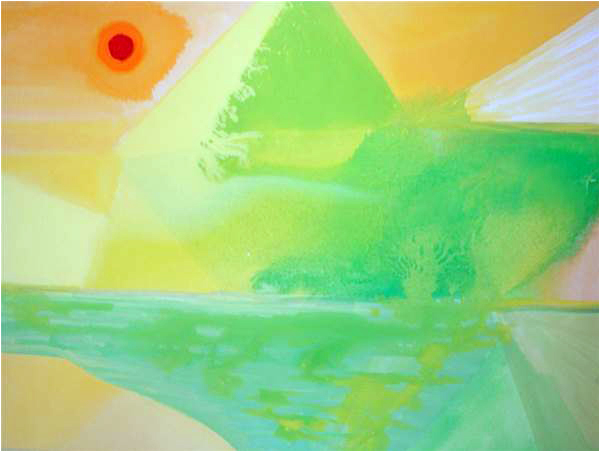
In from Daylight to Moonlight we read, “Moonlight floods the whole sky/ From horizon to horizon/How much it can fill your room/Depends on its windows ... “ At first the graceful figure and the exquisite composition demand one’s attention, followed by the rich colour, the texture, the gradual fade-out into the mysterious darkness of the universe. Then we start to wonder why the horizon is so close to the subject – but of course, the breadth and distance of this are determined by the windows in one’s room – that is to say the measure of one’s spiritual progress. The dancer, while still treading upon the stones of the earth, is ready to be consumed by the bright flame - another expression of the desire for total union with the divine. And leaving the state of earthly consciousness one is coloured by the levels of spirituality to which one rises, and the influence of the particular chakra in which one gradually becomes centred , blue for example being the colour of the throat chakra, which expresses the balance between the personality and the spirituality – or if one is a Tibetan Buddhist seeker, it is the colour of the blessings of the mind of all the buddhas.
Clearly describing love are the words, “You dance within my breast/Where no one sees you/But sometimes I see you/And that sight becomes this art.” Rumi could almost be saying this on behalf of Khusro who has presented here in vivid and contrasting colours the brilliance of the inspiration given by these words. The dancer himself is coloured by the vision, while the somehow rounded form of the composition seems to express both the terrestrial and the universal spheres.
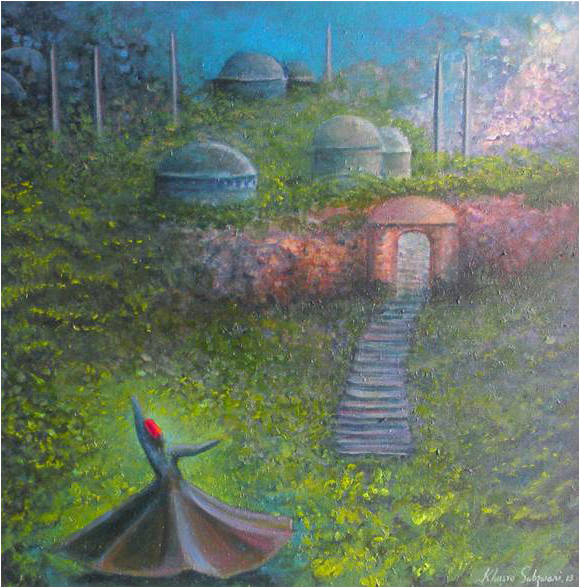
“Where there is ruin/There is hope for a treasure,” says Rumi, and Subzwari’s exquisite interpretation of this leaves one marvelling at his overall mastery. The similar colours of the costume and the staircase attract one’s attention firstly to the subject, while the skillful placement of the staircase leading into the ruins leads one’s eye naturally into the ruins amongst the unruly vegetation. Here, the placement of the buildings themselves leads one’s gaze right to the furthermost reaches of the composition and then beyond infinity. Meanwhile the glow of the pink clouds lights up the doorway and adjacent buildings.
The renowned Henri de Tolouse Lautrec once said that, “Only the human figure exists; landscape is no more than an accessory; the painter exclusively of landscape is nothing but a boor. The sole function of landscape is to heighten the intelligibility of the character of the figure.” We see the proof of this in Khusro’s work. In reply to Lautrec, Khusro says, “We can’t escape from the background - nature – it’s god’s creation and all around us. Nature has its own harmony and rhythm and this coincides with the whirling of the dervish. Celestial bodies too move a certain way, and if this harmony should break there would be total disaster in the universe.”
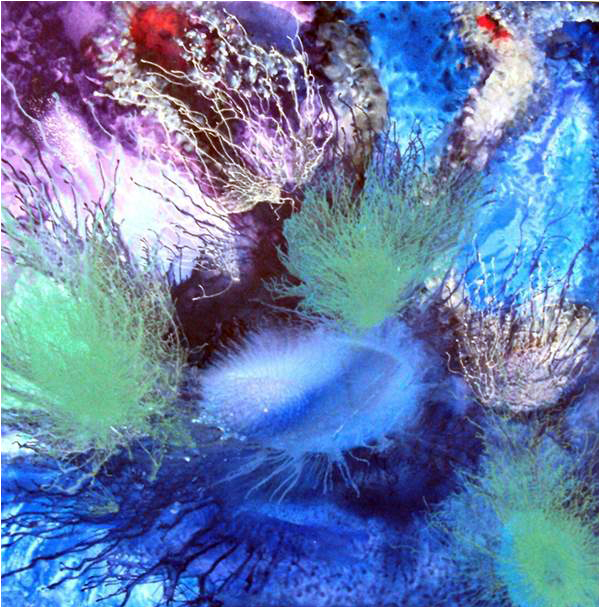
Another exhibition I attended by the same artist was “Colours of the Spiritual Journey” held at the Karachi Sheraton Hotel. Here he often started a picture by throwing colours onto his paper, and guiding them into the ideas that this presents, such as the plants within the blue ocean, the latter widely believed to be the primordial source of life on earth. In these paintings, the figure appears somewhat ghostly and transparent. The light emanating from behind the rocky ridge suggests the presence of the Divine, besides providing a variety of hue. The theme of water – sea and river water – looms large in this show.
Another submarine composition illustrates the poet’s “You are not one./ You are a thousand./ Just light your lantern.” No doubt the same technique of throwing paint on to paper has produced the aquatic plants on which the lantern, the aura of light and spirituality has settled, while a careful combination of washes has produced a pleasing, mottled background of green and gold. One imagines that from the gold other lanterns among the thousand are waiting to appear, while the romantic figure in the lantern makes a cameo-like appearance.
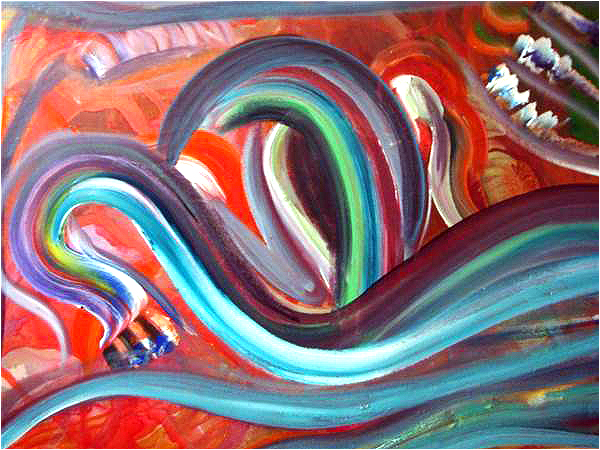
Many pictures in this collection have an interesting bubbly texture, the outcome of the artist’s study of building materials during his engineer’s course, and his use of acrylic paint. The question arises as to whether these bubbles are due to dexterous manipulation of the materials used, or produced haphazardly.
This particularly so in Khusro’s rendition of the lines, “Don’t sit and wait /Get out there, feel life/Touch the sun/And immerse in the sea.” The seeker is rising up towards the sun, presumably out of the ocean, an ocean so skillfully portrayed that one can feel the graceful movement of its waves this way and that. And particles of many kinds of matter, suggested by the bubbly texture and influenced by the spiritual energy of the seeker are rising up with him. The progressive change of colour in the washes as the energy rises nearer the burst of light from the sun is amazingly like a reversal of the colours of five of the the seven principal chakras within the human body.
Another point regarding Subzwari’s dervishes is the way in which he has captured the motion and character of their costumes, since a woolen garment, being a little heavy would swing more gracefully than one of a lighter cloth. “Sufi” means literally “wearer of wool” and long before the birth of Islam woolen dress was traditionally associated with the spiritual life. The term, which has profoundly venerable implications, was no doubt first applied to another group and later used by the Sufis.
Sufism is called the path of love, and it is certainly out of love and genuine inspiration that Khusro’s exhibitions have come into being. His work has been described as visionary and breathtaking, and this self-taught artist certainly knows how to bring an amazing variety into a single theme.

